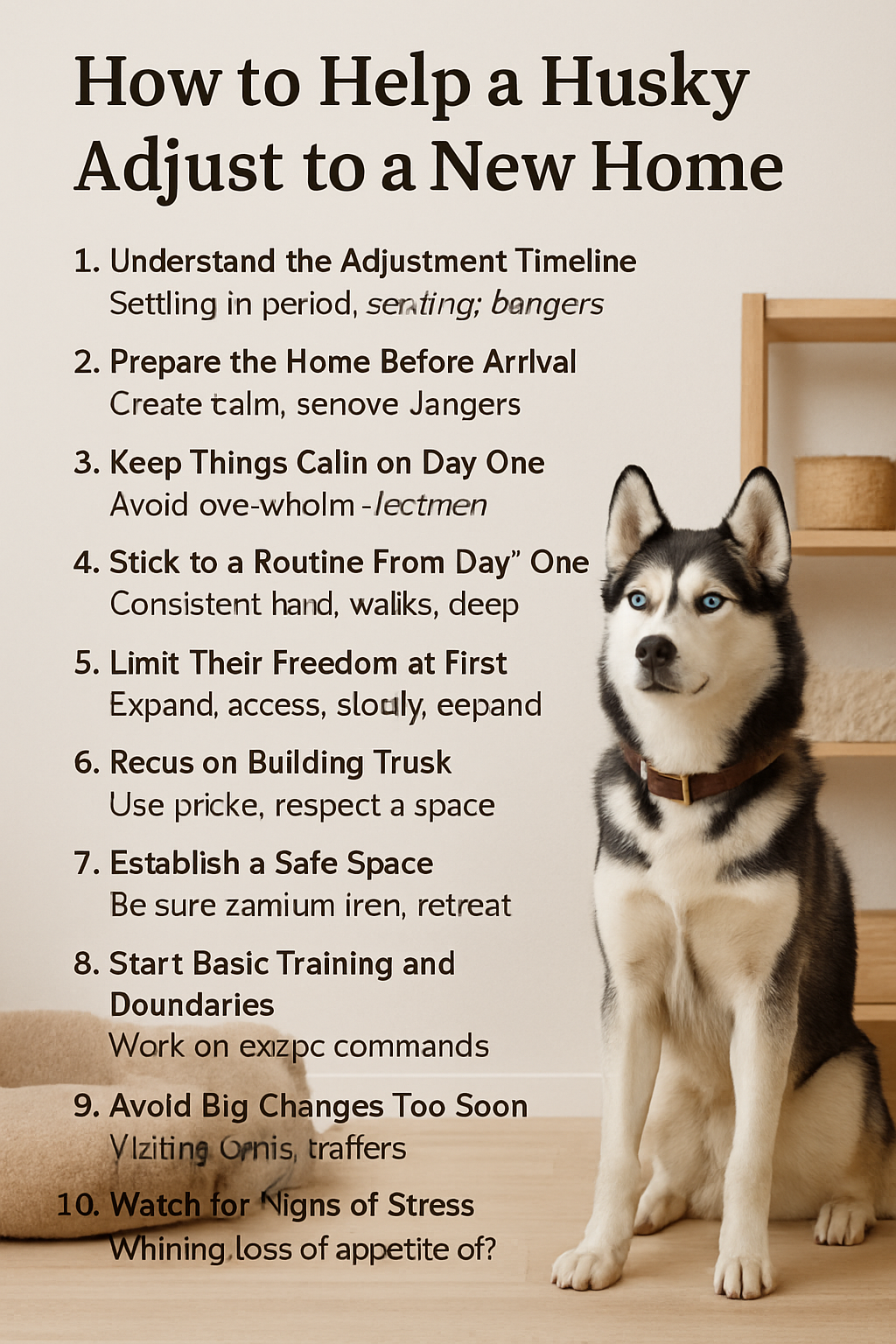Bringing a Siberian Husky into a new home is an exciting moment—but also one that comes with big adjustments. Whether you’ve adopted a rescue, brought home a puppy, or relocated with your current Husky, the transition can feel overwhelming—for both of you.
Huskies are highly intelligent, social, and sensitive dogs. They thrive on consistency and structure, which makes moving to a new environment especially challenging. Without the right support, your Husky may become anxious, destructive, withdrawn, or even try to escape.
Let’s walk through how to help your Husky settle in smoothly, feel safe, and build confidence in their new space.
Step 1: Understand the Adjustment Timeline
Every dog is different, but here’s a general breakdown of how long it takes a Husky to adjust to a new home:
- First 3 days: Overstimulated, unsure, or shut down. They’re just observing.
- First 3 weeks: Starting to settle in. You’ll see more personality and possibly test boundaries.
- First 3 months: Trust builds. Routines feel familiar. Real bonding begins.
Be patient. Some Huskies will adapt quickly; others need time—especially rescues with trauma or past instability.
Step 2: Prepare the Home Before Arrival
Create a calm, Husky-friendly space:
- Choose a quiet area for their bed or crate
- Set up food and water bowls
- Puppy-proof or dog-proof your home
- Remove dangerous items (cords, plants, small objects)
- Place a few toys to help with comfort and boredom
- Make sure outdoor areas are secure (Huskies are escape artists!)
If you’re moving into a new home together, unpack essentials first and avoid too much noise or chaos during the transition.
Step 3: Keep Things Calm on Day One
The first impression matters. When your Husky enters the home:
- Keep voices low and energy soft
- Don’t overwhelm them with people or excitement
- Let them sniff around at their own pace
- Stay nearby but give them space
- Offer treats for calm exploration
Skip the urge to introduce new friends or neighbors immediately. Let them settle first.
Step 4: Stick to a Routine From Day One
Huskies thrive on consistency. Establish a basic routine right away:
- Feeding times
- Walk times
- Potty breaks
- Quiet time and sleep
- Training and play sessions
Even in a brand-new space, this structure helps reduce anxiety and teaches them what to expect.
Step 5: Limit Their Freedom at First
Don’t give them full access to the entire house right away. Too much space can be overwhelming and lead to unwanted behaviors.
Instead:
- Use baby gates or closed doors
- Start with 1–2 rooms
- Expand access gradually as they show calm, confident behavior
This helps with housetraining, safety, and building a sense of “territory.”
Step 6: Focus on Building Trust
The first few weeks are about building a bond—not strict obedience or big adventures.
- Sit near them calmly
- Use soft praise and treats for good behavior
- Avoid harsh corrections or scolding
- Hand-feed meals if they’re shy
- Respect their space and body language
Let them come to you. Connection takes time—especially for rescued Huskies who may have been let down in the past.
Step 7: Establish a Safe Space
Whether it’s a crate, a dog bed, or a corner with a blanket, give your Husky a quiet place they can retreat to.
- Never use this spot for punishment
- Don’t force them to stay there
- Make it inviting with familiar smells and favorite toys
This becomes their “anchor” in unfamiliar surroundings.
Step 8: Start Basic Training and Boundaries
Once they’re more comfortable, begin working on:
- Name recognition
- Sit, stay, and come
- Leash walking
- Leave it and drop it
- Crate training or “go to your bed”
Training builds communication and structure. Keep sessions short and positive, especially in the early days.
Step 9: Avoid Big Changes Too Soon
Don’t overwhelm your Husky with:
- Trips to the dog park
- Long car rides
- Loud gatherings or parties
- Visitors coming and going
Wait until they feel secure at home and trust you. Then introduce new environments one step at a time.
Step 10: Watch for Signs of Stress (and Know When to Get Help)
It’s normal for your Husky to be unsettled at first. But if you notice ongoing signs of distress, you may need additional support:
- Excessive whining or howling
- Refusing food for more than a day
- Aggression or fear-based behaviors
- Housetraining regression that doesn’t improve
- Trying to escape repeatedly
Talk to a vet or dog trainer who specializes in behavior. Early intervention is key.
Final Thoughts: Patience Builds the Bond
Helping a Husky adjust to a new home isn’t about rushing results—it’s about showing them they’re safe, loved, and home for good.
With routine, kindness, and time, your Husky will relax, open up, and reveal their true personality—and when that moment comes, it’s incredibly rewarding.
Because when a Husky finally lets their guard down and trusts you? That’s when the magic really begins.
